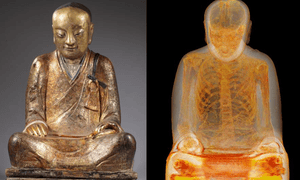
A gathering of Chinese villagers have ventured out to the Netherlands to make an energetic supplication for the arrival of the remaining parts of a 1,000-year-old priest as the lawful battle about its possession wrapped up in a Dutch court.
The little eastern Chinese town of Yangchun has blamed Dutch gatherer Oscar van Overeem for purchasing the stolen Buddha statue containing the embalmed stays of the priest in Hong Kong in 1996.
"We grew up with the statue. He was there day and night. He is our otherworldly pioneer," Yangchun town representative Lin Wen Qing said soon after legal advisors shut their contentions at Amsterdam area court on Wednesday.
"For us, it is the most imperative thing to have him back," said Lin, talking through a mediator. He was one of six villagers who headed out from Yangchun to go to the consultation.
The town is requesting that Dutch judges decide that the human-sized Buddha statue be come back to the sanctuary from where it was stolen in late 1995, in the wake of being venerated there for quite a long time.
Missing for two decades the statue, called the Zhanggong patriarch, reemerged in 2015 when villagers remembered it as a component of a showcase at the Mummy World Exhibition at Budapest's regular history gallery.
An output of the statue uncovered a skeleton inside – said to be that of a Chinese priest who lived about a thousand years back amid China's Song line. The statue was thusly pulled back from the show.
The case is as a rule intently viewed in light of the fact that it could stamp one of the main fruitful recoveries of Chinese relics in court.
The villagers said they were persuaded that the statue which Van Overeem purchased was their missing symbol. "There is an exceptionally uncommon bond between the villagers and the statue," their legal advisor Jan Holthuis told the judges.
Van Overeem emphasized in court that he didn't have the statue, which he said he traded in a swap with a Chinese gatherer in 2015. "I swapped the statue in an exchange. I was upbeat to hear that it would return to China," van Overeem told the court, including he didn't know the personality of the gatherer with whom he did the swap.
He dismissed Holthuis' cases that he was in reality a merchant in Chinese craftsmanship, and purchased the statue in Hong Kong in 1996 – a known goal for stolen antiques. "I'm a designer and an energetic authority. However, I'm not a merchant," van Overeem said. He said he didn't know where the statue was.
Past recoveries of Chinese antiques have been done through discretionary channels.
Beijing as of late has energetically challenged the offer of antiques that it said were stolen, especially in the nineteenth century when European forces started infringing on A chinese area.
0 comments:
Post a Comment